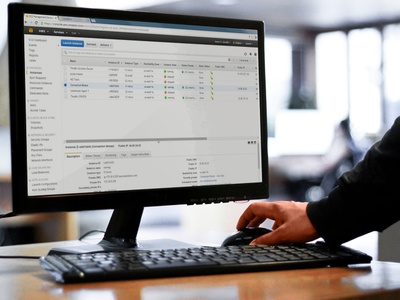 There’s no denying it, the as-a-Service market is booming! Go ahead, Google “as a service market” and just watch all the predictions roll in. From big data, to disaster recovery, to software, to desktops, if you’re a Managed Service Provider (MSP) you can define an offering and sell it to the world!
There’s no denying it, the as-a-Service market is booming! Go ahead, Google “as a service market” and just watch all the predictions roll in. From big data, to disaster recovery, to software, to desktops, if you’re a Managed Service Provider (MSP) you can define an offering and sell it to the world!
But, defining the offering is the easier or, at least, cheaper part of the story. Next, you have to build it, and the big money questions begin. Do you invest in your own datacenter? If not, do you rent space in a managed datacenter? But there’s a third, option, one that may be better, not only from a monetary standpoint, but from a functionality standpoint, as well. Why not look to a public cloud?
And, specifically, why not turn to Amazon, the current and clear market leader in public clouds? Amazon Web Services (AWS) provides a suite of services that make it ideal for as-a-service offerings, particularly workspaces and Desktops-as-a-Service (DaaS). Why am I comfortable with that claim? Well, let’s take a look.
Avoid Capital Expenses
For starters, you enjoy lower capital expenses at the beginning of your deployment, and over the course of its lifetime. Building a datacenter, or renting space in one, requires capital. Potentially, quite a lot of capital. If you’re building a new solution, even as an addition to an existing strong portfolio, wouldn’t you prefer to avoid large capital expenses? By using AWS, you do just that.
No more paying for servers. No more worrying about electric and air conditioning bills. No more dealing with datacenter maintenance. Instead, you estimate and (your customers) pay monthly fees to AWS. Amazon takes care of everything else.
Sounds like a bookkeeping nightmare, you say? Thankfully, there are a number of tools that can help out, some of which are mentioned in this post.
Free Tip-Sheet: Download our New Guide for Tips on How to Control DaaS Costs in AWS
AWS is more than just compute
Maybe avoiding capital expenditures doesn’t entice you to host DaaS in AWS. After all, any public cloud provides that benefit.
Ultimately, functionality is key, and AWS has it. If you haven’t peaked at the list of services provided in AWS, lately, give it a look. It’s not just for EC2 compute, anymore (if it ever was!) The Amazon Networking services, including VPC, allow you to segregate your customers into private segments of the public cloud. Directory Services provides an easy way to host or manage Active Directory services in AWS. S3 provides cloud storage, while Glacier is great for backups. And there are scores of other services that an imaginative MSP can work into their workspace-as-a-service solution.
You’ll note that I didn’t list Amazon Workspaces. That’s on purpose. If you need a few desktops in AWS, go ahead and give Workspaces a whirl. If you really want to provide a strong DaaS offering, however, Workspaces may not be for you. Wondering why? You’ll have to wait for my next blog! (Cliff-hanger!)
Faster, Higher, Stronger!
One year, that was the motto of my Cross Country team at MIT (albeit, in Latin.) It popped into my head while I was working on this blog. It occurs to me that AWS allows your desktops-as-a-service offering to be all of those things.
Faster – Not only can you quickly build your solution, you can almost instantly add and remove capacity. When a customer asks for 10 to 100 additional desktops, simply provision them in AWS. No need to buy, install, or maintain extra bits in your datacenter. And, faster doesn’t just apply to building and maintaining your environment. With the array of different compute sizes provided in AWS, you can provide users with a desktop performance that meets their needs. Fast applies to the desktop, itself, as well!
Higher – As in, high-availability is key when moving desktop loads into the public cloud. For this aspect, you can’t beat AWS. EC2 has a Monthly Uptime Percentage of 99.95%, so you can nearly guarantee that the user’s desktop is available. And, AWS has datacenters around the world. Not only does that mean you can place the user’s desktop closest to where they are physically located, it means you can provide fail-over desktops and backup in other availability zones or regions. In the event one EC2 region does experience an issue, you can use AWS tools to plan ahead and ensure that the user’s desktop and data is available elsewhere.
Stronger – The sheer level of maturity, scale, and breadth of functionality I previously mentioned, makes AWS the strongest contender for your desktops-as-a-service solution. They continue to expand their offerings (containers, anyone), which means an investment in AWS allows you to grow your portfolio, as well.
So, in conclusion
A recent survey by Citrix of their MSPs indicated that 50% of them are planning to move their desktop-as-a-service workloads to the public cloud by June 2016. If you are just starting to think about desktops-as-a-service, save yourself the hassle of transitioning and start in the public cloud from the get-go. Not sure you want to provide DaaS? Keep in mind, a desktop is another word for a workspace, and Workspaces-as-a-Service is going to be huge.
The problem with being in the lead (not that I ever knew this in Cross Country) is that there is always someone coming up on your six. AWS will always be great for DaaS. But, other cloud vendors are out there (Azure, anyone?). Depending on the workspace you plan to offer to your customers, maybe the future holds a better option for you. I, personally, can’t wait to see what 2016 brings for desktops in the public cloud.
